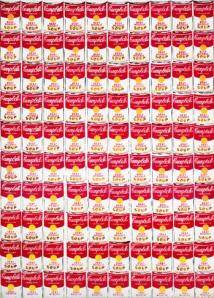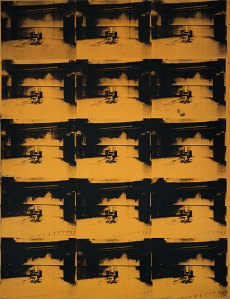“I am a deeply superficial person”- Andy Warhol
Andy Warhol (like Mies Van Der Rohe in architecture) is perhaps the most misunderstood and complex artist in history even though statements he made about his own work invoked a naive simplicity. This is perhaps why he is so misunderstood. Andy Warhol did not make it easy for the people of his time. He did not explain his work in emotional or historical terms. He was deliberately coy and naive. He made one think that perhaps his work was as vapid as he said it was. But in the corner of his blank stare was faint evidence that everything about this man was mired in sarcasm and irony. This irony was so thick it clouded the truth of what he was doing.
Andy Warhol was also hated and considered a threat because he seemingly broke the most important covenants of what made an artist: talent, originality, passion and preciousness. By undermining these sacred truths and throwing them into question he essentially pulled the rug out from under “fine art.” But, his work is much much more than merely iconoclastic. It brings up several layers of dual meanings. By breaking the rules he gave artists and patrons a whole new set of topics to explore.
Warhol negated the concept of artistic talent with this Pop Art works of the 60s. Instead of using the paintbrush, he blew up photographs stolen from newspapers or magazines and used the silkscreen process to make prints on canvas. These prints were then sometimes washed over with rudimentary color that was bright and intentionally not meant to evoke reality in the color scheme. Warhol said many times that this technique could be copied by any other person and repeated with similar results. In this vein of thought he called his art gallery the Factory and actually employed other people to manufacture his screen prints. He removed the artist from the process, or in other words, he removed the artist from the romantic belief of what an artist is. The romantic notion of the artist is that they are tortured souls that burst forth their creations in solitude and inner torment. Vincent Van Gogh was a perfect example of the fierce individual, spiritual, and suffering nature of the artist. People in general believe that true art can only come from such a personal place. Warhol made the argument that this is not always true or necessary. Warhol treated being an artist as if it was just a way to make money, but he was also making an ironic point about the glorification of talent and the aggressive individuality of the romantic artist. In hindsight we see that Warhol was unique, original and incredibly talented. No one actually did end up recreating or copying his work, perhaps out of fear of being labeled unoriginal (something which Warhol would have been thrilled about) or the fact that Andy Warhol did have an aesthetic eye and was able to capture the zeitgeist of his time better than anyone else. His delegation of his work to others shows that an artist is not just about individuality, but teamwork and oversight.
The use of repetition in the work of Andy Warhol is perhaps the most interesting and challenging components of his Pop Art. The use of the silkscreen negated the artistic covenant of talent, but the use of repetition negated the concept of preciousness. The famous 100 Campbell’s soup cans were quite a challenge to art patrons of the time. They were faced with a painting that showed a verbatim depiction of an object that they could see at the grocery store. Not only was the subject matter profoundly banal and devoid of emotional resonance, it was repeated 100 times to further its mundanity. When questioned about it, Warhol gave a typically vapid response that he simply loved the soup and ate it a lot. If this is to be taken literally, then one would believe that the painting has no actual meaning or merit. It didn’t take artistic talent to paint it, it is not individual, and it has no meaning beyond it’s surface level. Under the surface though, the very things that negate it give it special meaning. The personal story was very matter of fact. Warhol stated that he had soup for lunch everyday for twenty years and that he loved it. This ritualistic life is evoked in the relentlessness of the painting. On a level of social commentary, his repetition of the cans immediately evokes the image of their display at a grocery store. Perhaps Warhol was commenting that the popular Abstract Expressionism of the day was losing it’s meaning with it’s strict rules and homogeneous result. Or, perhaps, he liked the red and gold label! Any of these interpretations are possible and likely. His work is open to however many layers of meaning one wants to put onto it. It was very popular because the surface was captivating with or without the subtext.
His endlessly repeated images of Marilyn Monroe or Elvis Presley commented on our hero worship. They also seemed to contain a secret to the sadness of a superficial life. The famous are our replacements for deities. Warhol would say none of these more profound and troubling observations about these works were true. He would simply say that he liked Marilyn Monroe and Elvis. He would have a harder time explaining away the obvious subtext of media desensitization with his series of repeated car crashes, electric chairs, and wanted fugitives. These more gruesome series point towards a clearer social comment that Warhol was making with his work.
The use of repetition had a dual purpose: it was meant to deflate the notion of fine art as well as elevate the mundane aesthetic experiences of our everyday lives. The silkscreen technique negated the artist’s talent for painting but elevated the silk screen as something more than just a technique. Andy Warhol wants us to question the prerequisites of art; talent, individuality, preciousness and passion. By seemingly eliminating these elements he distills the art to its fundamental expression: technique. This opens the work up to various interpretations. One can look at his works and come to the conclusion that the guy was a hack or that he had a talent for making bold colorful images, or there was something else more profound and troubling in commentary to a consumerist culture that has replaced gods with product and hollow symbolism. Or maybe he just likes boring things. Andy Warhol took on the flavor of his time in an honest way, even if that meant that the world he lived in was increasingly devoid of a spiritual and emotional connection.
End Note: This is the second post in a row not about architecture. The next couple posts will explore the themes I’m exploring in fine art with architecture.







when was the paint by numers made
when was the paint by numbers made
1962.
Another possible interpretation, at least of the soup can prints, is that Andy Warhol was drawing attention to the art within the design of something as prosaic as a soup can. Someone has to design them, and there is an esthetic to a good design meant to attract attention and immediately convey it’s message of wholesomeness. Then, again, he may just have been commenting on the reduction of America’s aesthetic to the lowest common denominator. Let’s get an ouija board and ask him, if it matters that much.
as an art history student currently writing a paper on Warhol’s work, i really enjoyed your insightful reasoning behind Warhol’s motive and art. Warhol made a statement simply by not making a statement at all. he didn’t speak about what inspired his work or what it signified or even what it meant. unlike the Abstract Expressionists just prior to him, his work was not intended for elitism or promoting introverted idealism by rejecting the material world, instead he fully embraced the plastic society- mechanical process, consumerism icons- the lot. and whether you enjoy it as superficial surface kitsch or understand the possible underlying social commentary, you cannot deny that he brought art to the level where anybody could see it and understand a level of it for themselves.